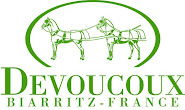A. Merrylegs, a black and white Sheltand pony. She taught two brothers and one sister to ride; she was the family pony. I started riding her when I was three and quit when I was eight.
Q. What was your life like when you were growing up?
A. I grew up on a horse farm in Kansas. My father retired from the military and he and my mother purchased a farm they turned into a horse farm. He was the Class of 1920 at West Point and was in the army all his life. Fort Riley was the Middleburg of the horse world then. The Calvary Training School was there. All the recruits were brought there and taught to ride; all the officers were given advanced riding instruction. It was where the Army Olympic team trained; it was the center of horse sports. You have to remember before 1952 all of the horse sports were military in nature.

U.S. Army photo
1932 US Army Olympic Team. Capt. John W. Wofford 3rd from right
Q. What is the history of horses in your family?
A. My father was born and raised on a farm in High Point, NC and then went to West Point, and at that time learned how to ride. He must have been horse crazy since horses were in our family from then on. He graduated in 1920 and by 1930 was on the Army Team. He rode in the Olympics in 1932; he was a show jumper. Then 20 years later, in 1952, he was the first president of the USET, which was formed to train, field, and equip Olympic and international teams in the equestrian discipline as successor to the army. In 1949 the US army mechanized and no longer had horses to provide young officers to ride so they needed some organization to fill that function. My father coached both show jumping and eventing teams in Helsinki in 1952; both teams got a medal. My brother JEB Wofford was a member of the eventing team then.

Wofford family picture
John W. Wofford, portrait
Q. What made you decide to attend the Culver Military Academy?
A. Culver had horses. That’s all that mattered. Like most young men, I had a hard time with discipline at first. However, the military was part of my life, so I soon settled into the routine and enjoyed my four years at Culver.
Q. When did you move to Virginia?
A. We moved to Virginia, my wife and I, in 1971 when I got out of the army. I was in the army from 1967-1970 and we moved back here in 1971 because of horses.
Q. What does the view out your window look like?
A. I’m looking west out my window. My farm is on the Eastern slope of the Blue Ridge Mountains outside of Upperville, VA. And looking away to the southwest, as I am now, you’re looking down the Blue Ridge Mountains. It still very much is country out here. Large horse and cattle farms. We were lucky enough to buy 100 acres 35 years ago when things were not as expensive as they are now. We could not buy ten acres now for what we paid for 100 acres back then. We bought the land in 1973 and have lived here on Fox Covert Farm ever since. There is a silent t for “covert”. In England “covert” is pronounced “cover” which is where a fox lives. It also means private, and we are private people. It suited us and suited the farm as there is a fox den on the farm.
Q. How did you meet your wife?
A. In ‘58 my brother had a string of horses out in Colorado Springs. I was thirteen and in between grade school and Culver. My father had passed away in 1955 so my mother sent me to Colorado Springs to ride with my brother. I met my wife, Gail, there. We are a strange story. I knew the moment I saw her that was the girl I was going to marry. And it came true and we still are. We’ve been together 51 years. We dated all through high school and college. We got married June 11, 1966 in Colorado Springs. Both of us were attending the University of Colorado. Right after my senior year we got married.

Wofford family picture
Gail Wofford on Perfect, bird hunting
Q. How would your wife describe you?
A. Difficult, absent-minded, stubborn, and sense of humor.
Q. Tell me about Pop.
A. Pop, or Carowich, was a 16.3 7/8 Thoroughbred, Irish Sport Horse. He was by a point-to-point stallion named Scratchy...isn’t that a horrible name? Scratchy was well known in the early 70’s in Ireland for breeding distance horses. All of the farmers used Scratchy if they wanted to produce a four-mile horse. was out of an unknown mare.
I first saw him in March of 1977. I had students at Badminton that I had been training and I was standing watching the vet check. I had been looking for a horse for myself to ride in the ‘78 championships. I was standing by my coach, Lars Sederholm (he coached me around my first Badminton and we had remained friends) and we were shoulder to shoulder watching the horses walk around the courtyard of the Duke of Beaufort’s hunting stables, which looks like a castle to you and I. We were waiting for the vet check to start and Lars was talking to someone to his left.
This big brown horse was walking by and he stopped and looked right at me. I got goosebumps. It was a bit of out of body experience. Horses don’t look in your eye, they look at shapes and sizes, but not in your eye. And he was looking at me in my eye. The groom kind of tugged on him. And he didn’t move. He kept looking at me. Then she really tugged and he went on and he had the most wonderful flowing walk. I grabbed Lars and asked who that was. He said, “That’s Carawich. He’s a wonderful horse but you’ll never be able to buy him”.
I watched him go with a girl called Aly Pattinson. And he was a cross-country machine. He had already won Burghley. It was the spring of 1977. Throughout that spring and summer I kept looking for a horse. Along by December I had pretty much given up. At that time the rules for competition required both the horse and rider to be of the same nationality before the first of the year of the competition. I don’t know why, that was the rule. So if I didn’t find a horse by January 1 of 1978 I was not going to ride in the World Games.
Does Wofford compete at the World Games? Does he ever ride Carawich?
Check back soon to find out.









No comments:
Post a Comment